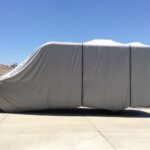This is a brief introduction to the Teardrop Trailer type of RV, intended to provide essential information for choosing the best RV type. (Looking for Teardrop Trailer Manufacturers?)
Not sure if this is the right RV type for you? Please take a look at our RV Types Pros & Cons Checklist.
What Is a Teardrop Trailer?

Definition of a Teardrop Trailer
A teardrop trailer is a miniature recreational vehicle (RV) with an interior sleeping area and an exterior kitchenette. Usually, the interior has sitting room only; some may have convertible dinettes. Most of the time, there are no bathroom or shower facilities. Teardrop trailers may be no bigger than a 4×8 sheet of plywood! They are also commonly called teardrop campers.
Unlike motorhomes, you tow a teardrop trailer. And no, you don’t generally need a special license to tow one!
Teardrop Trailer Specifications
Dimensions
- Lengths range from 10 to 16 feet, with 12 to 14 feet being the most common.
- Width ranges from 4 ft (narrow) to 6 ft (wide-body) – note these widths, unlike other RVs, do not count the fenders, which add an additional 20-30 inches!
- Height varies from 5 to 8 feet, with most ranging between 5.5 and 7 feet (roof fan included).
Driving an RV for the first time? Check out our guide to what you need to know about length, width, height, and weight!
Sleeping Capacity
Most teardrop campers can fit 1-4 sleepers (2 is standard). That doesn’t mean there’s room for everyone to clamber inside at the same time, though!
Teardrop Trailer Categories
The astonishing variety of teardrop trailers makes them difficult to categorize. No matter your taste, there’s a teardrop to sate it.
- Vintage/retro
- Expedition/off-road
- Resort/glamping
All teardrop trailers have an interior sleeping area (called the cabin) and an exterior kitchenette (called the galley) accessible by a hinged lift-up door (called the hatch). And yes, most of those are nautical terms.
Teardrop camper classes are often delineated by cabin width. Unlike most other RVs, teardrops have wheels and fenders outside the main body. For that reason, teardrop cabin widths range between 4 and 6 feet, with very few wider than 6 feet.
In fact, the term “teardrop” has become an umbrella term for many types of miniature travel trailers, some of which don’t even have the classic raindrop shape!
But a true teardrop trailer does not have standing headroom. Classic trailers had 4 feet (or less) of interior headroom. Modern teardrops may have 5 or even 5.5 feet, but generally, once a camper has sufficient room to stand and move around, it’s no longer a teardrop trailer, and it should be considered a travel trailer.
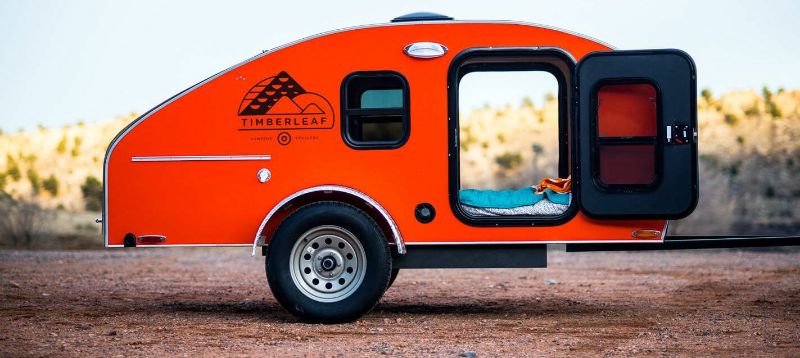
Teardrop Trailer Description
Teardrop trailers are cute, aren’t they? You can’t walk by one without smiling, gaping and wondering, “What if I …?”
These miniature campers hale from the post-WWII era, where they were originally built out of surplus aircraft aluminum and 4×8 plywood sheets!
80 years later, the original design remains beloved: sleeping cabin inside, with everything within arm’s reach; galley kitchen outside, protected by the rain and wind from the sloping walls and arching hatch lid.
Teardrop trailers do not have bathroom or shower facilities. Some may have outdoor showers with pop-up privacy tents; some have porta-potties cleverly stowed in a hidden cargo compartment.
A teardrop trailer gets its name from the tear-shaped profile—pointed in the back and rounded in the front. The shape notwithstanding, some manufacturers group all very small trailers into the teardrop category.
In general, teardrop trailers are small and light, towable by large cars and SUVs. Some are small enough to be towed by motorcycles.
Most teardrop trailers are so small that they provide only the very basics: bed, a small amount of inside storage, and minimal external cooking facilities. Some models are large enough to accommodate inside cooking and dining.
Clever storage is what defines a teardrop just as much as the classic streamlined shape. From overhead cubbies to under-mattress drop-floors, from sliding stove drawers to custom coolers, teardrops are chock-full of nifty nooks and smart space-saving solutions.
Teardrop Trailer Chassis & Fuel Economy
Teardrop trailers are built on light-duty chassis frames. Unlike most RV frames, which are either built from high-strength-low-allow sheet metal or structural steel sections (I-beam, etc.), teardrop campers are often built on lightweight steel or even aluminum chassis frames.
While some teardrops ride on a simple leaf-spring suspension, many boast torsion axle or independent suspensions like FlexiRide or Timbren Axle-Less.
The chassis frames are usually designed and/or fabricated by the RV manufacturer or a local fabricator. There are no major industrial players for mass-produced teardrop trailer frames.
Because of the light weight and low profile of a teardrop trailer or miniature camper, they have very little impact on fuel efficiency. Some pickup trucks drivers report only a 1-2 mpg difference when towing a teardrop!
- Average Fuel Economy (gas/diesel): 2-5 mpg difference
Who Might Want a Teardrop Camper RV?
People are attracted to teardrops for all sorts of reasons.
- Some are looking for a camper lightweight enough to be towed with a small passenger vehicle.
- Some want a hardcore expedition trailer for Jeep trails, one with a roll cage (preferably).
- Some want an affordable camper trailer with more security than a pop-up or tent trailer.
- Some want to enjoy their empty nests and travel, two only.
- Some want a mini camper to match their vintage restored automobiles
- Some want to be outside adventuring, all day, and they don’t have time to put up a tent every evening.
Teardrop Camper RV Pros and Cons
PROS
- Can be towed by almost any vehicle! Weigh ranges from 600 to 2,000 lbs.
- Low-profile has minimal impact on fuel efficiency.
- Tow vehicle doubles as local transportation.
- Lower profile allows easier entry than any other camper.
- Can normally be stored in a garage or under a carport.
- Lower profile allows roof storage of items such as canoes, with less concern for top clearance.
- Can be towed with a variety of vehicles fitted with a standard ball hitch and rated for the trailer weight.
CONS
- Usually, no bathroom. Only the largest teardrops have a bathroom or shower facilities.
- Smallest of all the RV and camper types. Not a great space for a rainy day!
- Limited to tents and awnings for living area expansion. No slide-outs.
- Less storage than other types of campers.
- Kitchen and living compartments are separate. No luck if you’ve got the munchies!
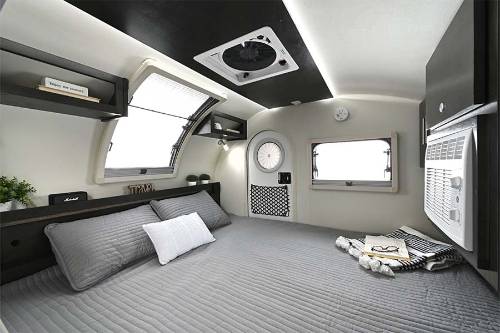
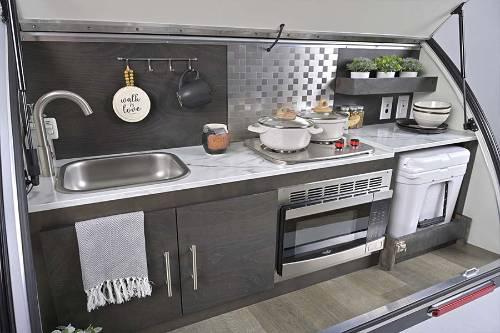
Key Features in a Teardrop Trailer
The galley is arguably the most appealing part of a teardrop camper. The clever storage, the beautiful stainless steel finishes, the wow factor when popping the hatch – everyone loves it!
Also remember that most of the cargo space on a teardrop is on the body. Pay close attention to exterior storage options on the sidewalls, roof, rear receiver (optional) and A-frame tongue (optional).
Sleeping and Living Space
Teardrops are usually designated by their overall body width and length. Common sizes include:
- 4×8
- 5×8
- 5×9
- 5×10
- 6×10
- 6×12
A 5×10 or 6×10 teardrop camper is the Goldlocks choice. Any narrower, and two people cannot sleep comfortably side by side. Any shorter, and either the cabin or galley will be too shallow for optimal comfort or storage. Longer is optional, but it may become difficult to store a teardrop in a residential garage, which is one of their perks.
Check out this 2022 Braxton Creek Bushwacker 10FB for a conventional 2-person teardrop trailer floorplan layout:

Occasionally, mini campers designed to be towed by a motorcycle may be even smaller than 4×8, such as 3×7! These campers are commonly called “sleeper” teardrops, although they aren’t true teardrops since they lack the outdoor galley.
Because the wheels of a teardrop are mounted underneath fenders outside the main body, it is rare to find a teardrop over 6 feet wide. This is because 72 inches of body width plus 11 inches per fender equals 94 inches, which is just under the road-legal limit of 96 inches (8 feet) for many neighborhood and backcountry roads.
Kitchen and Comfort Needs
Some teardrops come with outdoor showers, fresh and gray water tanks, built-in propane heating and heated water, and a private butler.
Others came with the bare minimum: some shelving and a few outlets.
Which do you prefer?
Which can you afford? A barebones teardrop can be purchased factory-direct without options for under $10,000. A fully outfitted resort model can cost $30,000 or more!
Here are some common options that you may consider:
- AC/DC fridge/freezer
- Microwave
- Extra freshwater storage
- Gray water tank
- Water heater (6-gallon or instant)
- Air conditioning
- Skylight
- Roof rack
- Propane system
- Extra batteries
- Solar panels
Off-Road Capability
Teardrops are popular with the adventure expedition crowd. Due to their small stature, they boast excellent approach, departure and ground clearance capabilities. Narrow models even have the same wheel track as a Jeep, allowing laser-like precision on the trail.
If you’re choosing a teardrop for its rough n’ toughness, evaluate the structure carefully. What sort of suspension does it have? Will it break if rolled? If aluminum, are the welds or huck bolts strong enough to survive shock and fatigue?
Is the trailer large enough (with sufficient GVWR) to carry extra batteries and freshwater for boondocking?
Teardrop Trailer Sub-Types
The Classic teardrop, as described previously, has a 2-person cabin for sleeping and an open galley for cooking and food preparation.
The teardrop trailer RV has two sub-types:
1. Sleeper Teardrop
The name gives it away—a bus conversion is a commercial passenger bus that has been converted into an RV. Some bus conversions are easy to spot because their previous skin is mostly intact. Often these look like a Greyhound bus. Some bus conversions undergo major remodeling inside and out, and are more difficult to see their origin. One of the most used platforms for luxury conversions is the Prevost bus.
Though not sub-types, people often refer to some Class A’s as a pusher or diesel pusher. A pusher is a motor home with rear mounted engine for the purposes of better accommodating large engines. Two other benefits of having the engine in the rear is the reduced engine noise and the ability to install the main door near the front of the vehicle.
2. “Boxdrop”
Unlike a classic teardrop with a streamlined shop, “boxdrops” (which go by many, many other names depending on the exact profile) usually have a more vanilla boxy design.
However, the boxy body allows for more variety of interior layouts. Some boxdrops have convertible dinettes, partial wardrobes, or extra-deep galleys.
Boxdrops tend to be taller than classic teardrops, often around 5-plus feet inside. However, if the camper offers standing room, it should be considered a miniature travel trailer.
Teardrop Trailer Major Manufacturers
There are about 13 major teardrop trailer manufacturers in North America.
Some of the biggest names include:
- NuCamp
- Little Guy
- Geo Pro by Rockwood
- InTech RV
- No Boundaries by Forest River
Some so-called “teardrops,” such as the Little Guy Max or Forest River R-Pod, are better considered miniature travel trailers.
For a full list of major mainstream manufacturers, check out our comprehensive RV manufacturer’s list!
For a full list of specialty teardrop manufacturers, check out our dedicated page to teardrop and micro camper manufacturers and builders.
However, the industry is dominated not by one or two big builders, like most of the RV industry, but by a half-dozen midsize manufacturers and dozens of smaller operations. Many of these builders specialize in high-end, bespoke design.
There are also dozens of custom coachbuilders who will design you a bespoke teardrop trailer complete with custom walnut furniture, skylight, flat screen TVs on the ceiling, or whatever else your heart (and wallet) desires.
We’ve spotlighted a few brands below. These brands are either known for their popularity, quality, or innovation.
NuCamp

NuCamp is an RV manufacturer based in the state of Ohio and has been in operation since 2005. The company is owned by Pleasant Valley.
Known for their T@B and T@G teardrop campers, NuCamp has expanded into the lightweight truck camper and travel trailer markets. Their teardrop campers have set the standard for classic luxury teardrops for many years.
InTech RV

InTech RV is an RV manufacturer based in the state of Indiana and has been in operation since 2010. The company is owned by private ownership or family.
InTech RV builds futuristic, forward-thinking adventure teardrops and all-aluminum cage mini travel trailers. Their Flyer series is a well-built adventure boxdrop, and their Luna is a forward-learning take on the classic teardrop.
Camp Inn

Camp Inn is an RV manufacturer based in the state of Wisconsin and has been in operation since 2001. The company is owned by private ownership or family.
Although not a high-volume manufacturer, Camp Inn has long been regarded as one of the best custom and premium teardrop manufacturers. Their unique rounded front noses and all-aluminum exteriors are reminiscent of Airstream, while their woodworking and craftsmanship is regarded as second to none.
Vistabule
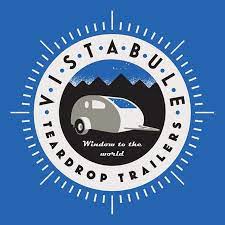
Camp Inn is an RV manufacturer based in the state of Wisconsin and has been in operation since 2015. The company is owned by private ownership or family.
You’ll never feel claustrophobic inside a Vistabule teardrop camper! The company is known for its oversized glass windows, skylights, and dual-door designs that make a teardrop camper feel twice as big as it looks.
Teardrop Trailer FAQs
Yes … with restrictions.
They excel at stealth camping since they can be parked and towed almost anywhere, urban or rural.
With sufficient clearance, teardrop campers can access out-of-the-way locations. Just remember to bring some Fix-a-Flat when primitive camping!
But you won’t have much room for lots of fresh water, extra propane, or extra batteries, or a generator. So you’re limited on how long you stay. And most don’t come with toilet facilities, so you’ll be digging a cathole.
Teardrop trailers are also good for base camping since you don’t need to tow a second vehicle. Just use your tow vehicle as a daily driver!
No. Generally, you cannot “triple-tow” with a ‘drop. Even states that allow triple-towing generally do not allow it with a camper trailer because of maximum motorcade length and weight restrictions.
However, you can just use your tow vehicle as your daily driver!
Almost any vehicle will do!
Most teardrops range between 600 and 2,000 pounds, with the average around 1,200-1,500 empty.
Some many can be towed with typical passenger vehicles like two-row crossovers, small pickup trucks, SUVs – even strong sedans or wagons!
Most teardrop trailers top out at 2,000 to 3,500 lbs GVWR.
To help you answer this question, please took a look at these two resources:
Related RV Checklists
The following RV checklists on our website are applicable to teardrop trailers:


